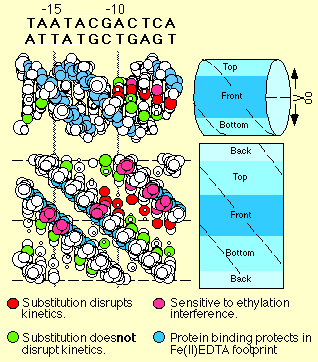 Through "functional group mutagenesis" we have mapped the important contacts along the surface of the promoter DNA. These results demonstrate that from position -12 through position -5, the protein directly "reads out" unique functional groups in the major groove. This appears to be the primary mechanism for sequence specificity in binding, and indeed likely provides the vast majority of the promoter binding energetics.
Through "functional group mutagenesis" we have mapped the important contacts along the surface of the promoter DNA. These results demonstrate that from position -12 through position -5, the protein directly "reads out" unique functional groups in the major groove. This appears to be the primary mechanism for sequence specificity in binding, and indeed likely provides the vast majority of the promoter binding energetics.
In the above results, very large perturbations can be introduced on the "back" side of the DNA without substantially altering promoter binding. In contrast, some very simple substitutions on the side of the duplex which faces the protein weaken binding significantly. This pattern of behaviour demonstrates that recognition follows a very simple "direct read-out" mechanism.
At position -5, we see evidence for contacts on what may be the minor groove side of the DNA. This is in keeping with the idea that the enzyme contacts one face of the helix. Downstream from position -5 (positions -4 through +2), the enzyme contacts the template strand exclusively. Substantial modifications can be introduced into the nontemplate (top) strand without altering the kinetics of initiation. Indeed, the entire nontemplate strand in this region can be removed without slowing transcription or weakening binding! In contrast, changes to the template strand do either slow turnover and/or weaken binding.